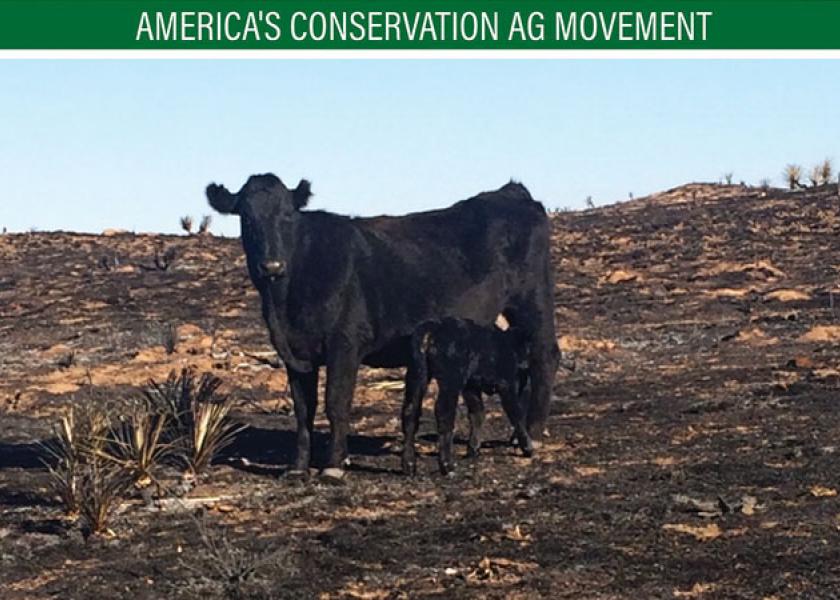Rebuilding from Fire: Resiliency Defines this Community

Building trust in food begins with empowering farmers through one of the largest and most diverse conservation- and sustainability-focused public-private partnerships in our nation’s history: America’s Conservation Ag Movement. To find the latest news and resources related to the Movement, visit AgWeb.com/ACAM.
Nearly every resident of Ashland, Kan., and the surrounding communities was affected by what was called the worst fire in Kansas history — the Starbuck wildfire of 2017.
Bolstered by 60 mph winds, the Starbuck fire raged across ranch land in four states burning 1.6 million acres, killing 10,000 head of livestock, damaging or destroying 18,000 miles of fencing and more than 150 structures. Not to mention millions of dollars of damage to equipment and supplies.

It took days to tend to all the injured cattle, humanely euthanizing those that were too severely injured. But aside from the devastation and emotional toll such a task wreaks on both rancher and veterinarian, Randall Spare of Ashland Veterinary Center, says one of his biggest callings was also to love on and show support for the people in the community.
“As veterinarians, we understand that in times of tragedy, when we have the [prior] relationship with people, we’re able to help more than any sort of emergency organization,” Spare says. “We could call and say, ‘Is there anything we can do to help you?’ We knew who the people were that weren’t as closely connected and could build the relationship.”
For Bernie Smith, witnessing the destruction was two-fold, as a rancher and chief of the Englewood Volunteer Fire Department, he was on the front line fighting the flames as his own ranch suffered loss.

Out of that devastation rose a pillar of strength. People banded together, and the land healed itself.
“People are much more fire aware now. More have taken out fire insurance on their cattle and have a plan for where they can take their cattle if a fire breaks out,” Smith says. “We have a strong fire community of people to help run the fire trucks, and we’re figuring out how to grow that as well.”
The winds that day boosted the speed the fire traveled and the heat it generated. This affected the grass in ways a controlled burn wouldn’t. It killed much, but not all, of the trees and invasive brush in the area.
“One of the biggest things we learned is that the land will recover quickly if we get a little rain, and if we just give it a little break,” Smith says. “The grass is not quite back to normal yet, but the fire cleaned up a lot of the invasive brush. The fire did a lot of bad, but it also did a lot of good for the grass. The country is a lot more open and the grass has a chance to grow,” Smith says.
A sense of community banding-together was echoed by Kendal Kay, mayor of Ashland and president of the Stockgrowers State Bank. Within a week, a task force was formed to spearhead each arm of the recovery and manage volunteers that came from nearby.
“It’s not easy for people in rural America to accept help,” Kay recognizes. “That was a challenge. Volunteers were here, and you’d call rancher, and he’d say, ‘No I’m fine. I don’t need help,’ but in reality they did need help, they just didn’t want it at the time. We finally said, ‘We’re going to send you two people today,’ and what we figured out, is that became a breath of fresh air. Those two people were not only there to help roll up wire and clean up the mess, but they were also there to just listen, and that was so valuable.”
Although natural disasters can’t be predicted, all three men learned lessons they carry with them to prepare for the future.
For Spare, that includes building bonds with the younger members of the community to cultivate future veterinarians to serve in rural areas, as well as learning the importance of delegation.
About five days after the fire, Spare had been on the phone coordinating veterinary care and donations, whatever he could do to help. Someone stopped him, however, and pointed out the pace at which he was working wasn’t going to be sustainable in the long run.
“We may be the leaders, but we can’t do it all,” he says. “Our community came alongside. Even people who didn’t own an acre, or didn’t own crops, they came together to help organize the recovery effort. You can’t be afraid to ask for help.”
From a coordination standpoint, Kay had a quick idea to create a flier that detailed in succinct bullet points how people could help and where to go to donate. It was easy to distribute, and that, paired with the task force, are elements that they keep in their toolbox for future emergency situations.
And just like the strength of the people, the grass has risen from the ashes. It was dry just following the fire, but it’s come back greener and gets a little better each year, Kay says.

Inspired by the helping hand they received, Smith and a few others started the “Ashes to Ashes Convoy,” which collects hay and monetary donations for areas affected by fire and trucks it out to those communities, just as hay was donated to them following the Starbuck fire.
“It’s just a bunch of local people— firemen, farmers, ranchers and truck drivers; when something comes up, we blow the horn and they come and help,” Smith says. “We really enjoy going and helping those people, and they really are appreciative of it. It’s our way of paying back all the help we got.”
Related:







